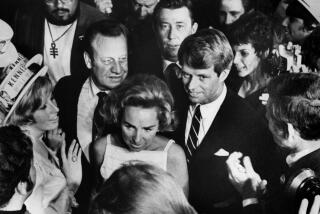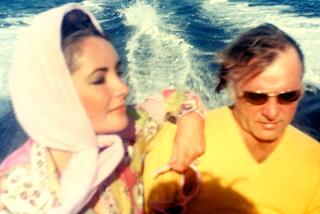Another Portrait of an Ever-Fascinating First Lady
- Share via
I must confess, if I never again hear the words “king,” “queen,” “dynasty” or “royalty” applied to prominent Americans, that day can’t come too soon. For the citizens of a republic, expressly dedicated to the proposition that all men (and, let us hope, women) are created equal, to grovel and gush over individuals whose chief distinction is their celebrity or social position is not a healthy sign.
Admiration, respect, fascination, even envy, however, are quite a different matter, and there is no doubt that Jacqueline Kennedy Onassis inspired all this and more. The qualities that first made her shine so brightly in the public eye were relatively superficial: good looks, charming manners, a notable degree of cultivation (including fluency in French and Spanish) and a certain sense of style. Yet, there was also a sense of deeper qualities--the dignity and courage she displayed throughout the nightmare of her husband’s killing, her dedication to her children’s welfare, her loyalty to friends and her ongoing efforts to shun the limelight.
There was plenty to disapprove of as well: her spendthrift ways, her relative lack of interest in charitable causes and, of course, her ill-starred marriage to Aristotle Onassis. In her later years, however, working as an editor, first at Viking, then at Doubleday, Jacqueline Kennedy Onassis seemed truly to hit her stride: Authors found her a helpful and encouraging editor, colleagues liked and respected her.
Sarah Bradford, a British author whose previous subjects include Benjamin Disraeli, George VI, Princess Grace and the current Queen Elizabeth, is the latest (although probably not the last) biographer to recount “Jackie’s” life story. “Jackie” is what Bradford calls her in the book: Biographers of women often find themselves resorting to being on a first-name basis with their subjects because so many women acquire more than one last name over the course of their lives (not to mention women who become known by their pseudonyms, like George Eliot and George Sand). Nonetheless, combined with the somewhat over-familiar tone that Bradford takes, the effect here is a bit patronizing.
The private Jacqueline Kennedy, Bradford feels, was in many respects even more engaging than the public persona she felt it necessary to project. While the first lady was gracious, serene and slightly reserved, the real Mrs. Kennedy could be mischievous and witty. The real woman, however, was also prone to moodiness. Bradford credibly sees Mrs. Kennedy’s sometimes-disconcerting ability to withdraw or “tune out” as a mechanism she developed in her girlhood in response to the ugly recriminations and vituperations that accompanied the dissolution of her parents’ unhappy marriage.
To research a biography like this one involves, among much else, wading through a veritable quagmire of gossip. Bradford, who conducted extensive interviews with people who knew Jacqueline Kennedy Onassis, is too seasoned a biographer to present everything she’s been told as gospel truth. But she can’t quite resist the temptation to repeat (without officially confirming) a lot of stories she can’t substantiate: a way of having her cake and eating it too. Bradford is seldom guilty of gross inaccuracies or outright misrepresentation. But she belongs to the cut-and-paste school of biography, offering little in the way of solid judgment: “Authoritative” is not the word for this biography.
In a typical passage, Bradford discusses how Jacqueline and her younger sister Lee were treated by their mother, Janet Lee Bouvier Auchincloss: “ ‘Both girls hated their mother,’ said a friend. . . . ‘Jackie had a very close semi-incestuous relationship with her father. . . . Janet didn’t like her daughters. . . .’ ” “Janet’s violence toward her children,” Bradford remarks, “continued even when they were adults: ‘Michael Canfield told me that Janet would strike her [Jackie] in fits of temper,’ a cousin said . . . Perhaps it would be truer to say that the girls resented Janet’s constant carping criticism.” Why would it be “truer”? Does Bradford believe or disbelieve her sources who claim Janet was physically violent? And how about defining “semi-incestuous”?
While Jacqueline Kennedy Onassis may not have been a great woman on the order of Eleanor Roosevelt, Madame Curie or Mother Teresa, one feels she deserves more measured and thoughtful consideration than she receives in this biography.
More to Read
Sign up for our Book Club newsletter
Get the latest news, events and more from the Los Angeles Times Book Club, and help us get L.A. reading and talking.
You may occasionally receive promotional content from the Los Angeles Times.










